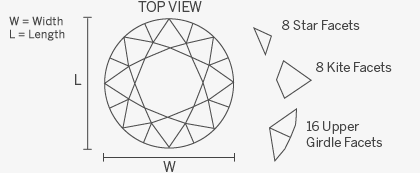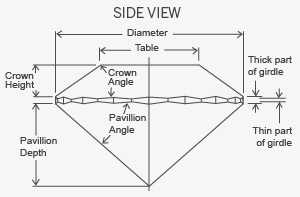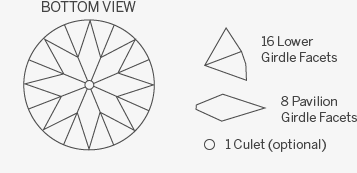Round Diamonds Shape
The Essential 7C's
Every diamond has its own story, and every lady her own style.
At this point it should be noted that the shape of a diamond can also be referred to as its “cut”, like a round or princess cut. However, this should not be confused with the more commonly used term of diamond cut, which describes how well the diamond has been polished from the raw material (see section on diamond cut).
At Seventy Seven Diamonds we cater to the detailed wishes of every customer and want to ensure that they are well-informed about every diamond shape available. Our selection of beautiful shapes is accompanied by detailed information, images and recommendations on the uniqueness, the history and background, and the ideal ratio of every cut.
Round Brilliant Diamonds
1. The Basics | 2. Features | 3. Expert Advice | 4. History
1. The Basics
Also referred to as: TOLKOWSKY IDEAL CUT

| Unique Features |
Facets |
L/W Ratio |
Origin |
Expert Tip |
| Considered to be of ideal proportions to maximise brilliance and fire. |
58 (57 if culet pointed) |
1.00 - 1.02 |
17th Century Mazarin |
Most brilliant and popular of all shapes; versatile and classic. |
2. Features



The round brilliant cut is the most popular diamond shape, accounting for more than half of all diamonds sold today. Although developed in Europe, the round brilliant is sometimes referred to as the American Ideal Cut.
With 58 facets divided amongst its crown, girdle and pavilion and a typical ratio between 1.00 and 1.02, it yields maximum shine as the cut naturally follows the rough diamond crystal.
The round brilliant is the most researched cut in the industry; for over a century, diamond cutters have used advanced scientific theories of light reflection and precise mathematical calculations to optimize its fire and brilliance.
3. Expert Advice
“The round brilliant is the most versatile of all cuts both in terms of style and value. With more fire and brilliance than any other shape, this cut offers the ideal balance between cut, colour and clarity grades and budget.
For a bachelor unsure of what might please his lady, it is hard to go wrong with this classic choice.”
4. History & Background
The origins of the round brilliant cut can be traced back to the middle of the 17th century when diamond cutters began using more refined and complex ways of cutting diamonds. The early brilliant cuts were known as Mazarins, after their designer Cardinal Mazarin, who made the first cross-cut diamond in 1650.
Through a series of gradual transformations and developments over the course of the 18th century, the Mazarins gave birth to the Portuguese Peruzzi, “old mine,” or “old European cut” in the 1700s.
It was not until 1919 that the early modern round brilliant was created; at the time it was referred to as the Tolkowsky cut named after its creator, Russian mathematician and diamond enthusiast Marcel Tolkowsky.

Where next?
To view round brilliant diamonds offered by Seventy Seven Diamonds, please click here.
To customise your round brilliant engagement ring, please click here.
If you would like to read more about diamond education, please click here.